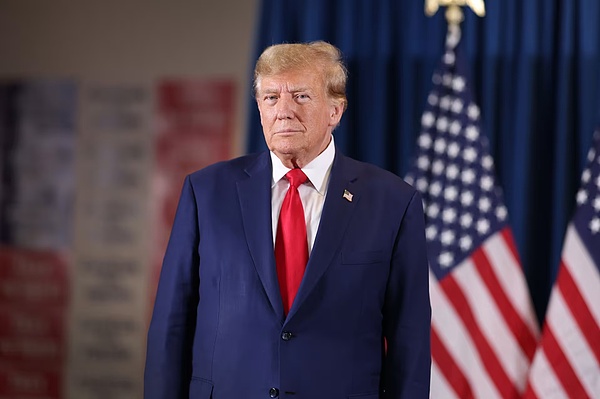Source: Barron’s Chinese
Some major dynamics have changed since 2017, one of which is that China is no longer as dependent on the US market as it was in the past, which means that China has multiple options for countermeasures.
At present, the theme of the "Trump deal" has been replaced by the theme of the "Grand Bargain" between US President-elect Trump and China.
Despite Trump pulling Canada and Mexico into a large-scale "trade war" against China and choosing more anti-free trade people to serve in the new government, US stocks still rose sharply last week.

So are investors right to think that the Trump circle's strategy of "escalating the situation to achieve the purpose of de-escalation" can work? I think the probability of this strategy working is not high.
There are two different questions involved. The first question is, what is Trump's plan? It is well known that he hopes to use the threat of high tariffs to get China to yield to American demands, and Trump's appointment of Scott Bessent, a new member of the MAGA camp (short for "Make America Great Again" and Trump's campaign slogan), as Treasury Secretary has given people hope that the tariffs are just a negotiating tactic.
The second question deserves more attention: How will China respond to the chaos brought by the coming "Trump 2.0"? Perhaps not as "compliant" as many people think.
After all, China outmaneuvered Trump at almost every critical moment in the last "trade war" launched by Trump, and Trump's missteps since his victory on November 5 show that he has not learned much from that experience.
Trump seems to be dissatisfied that the "trade war" from 2017 to 2021 did not prevent China's rise on the global stage. Instead of reducing China's trade surplus and returning millions of jobs to the United States, the "trade war" has flowed to Vietnam.
Ask American farmers, manufacturers and small business owners whether China has paid a price for those tariffs, or ask Japan, South Korea and U.S. allies in Southeast Asia how they feel about Trump’s 1,460 days in office after January 20, 2025, and you will find that Trump’s “revenge tour” has failed first in Asia.
At the same time, China knows that Japan is still resentful of Trump’s withdrawal from the U.S.-initiated Trans-Pacific Partnership (TPP) in 2017, because the TPP was the centerpiece of Japan’s series of attempts to contain China.
Trump 2.0’s threat to impose 25% tariffs on Canada and Mexico has had about the same effect as before, and other major U.S. trading partners are watching closely, fearing that negotiations with U.S. officials will come to nothing again.
Among the most worried may be Japanese Prime Minister Shigeru Ishiba, who has yet to get a chance to meet Trump at Mar-a-Lago, and whose team has made clear that it would be OK to have the leader of America’s staunchest ally in Asia, if not the world, on side, etc.
Trump 1.0 wasn’t very friendly to Japan either, and the flattery and deference of former Japanese Prime Minister Shinzo Abe, who had used a lot of political capital to convince his Liberal Democratic Party to join the TPP, didn’t stop Trump from withdrawing from the TPP.
China, which has observed all this, has learned some lessons, one of which is that Trump will never be satisfied, and he will keep making demands, and the demands will keep getting bigger.
Assuming that China decides to sit down with Trump and conduct a “grand negotiation” between two countries with a combined annual economic output of more than $47 trillion, the Trump team will most likely be disappointed that China will not accept his demands, and the counterattack will begin again. At the same time, if major concessions are made to Trump, China knows that Trump will make more demands a year later.
Some major dynamics have changed since 2017. One is that China is no longer as dependent on the US market as it was in the past, which means that China has a variety of counter-measures.
One option is to devalue the renminbi before Trump devalues the dollar to offset the impact of the 60% tariff.
In addition, China may restrict exports to the United States of key goods needed for "Trumpnomics". Of course, Musk and his colleagues in Silicon Valley can explain to Trump the risks of the United States not being able to obtain rare earths and other materials. Reduced imports of gallium, germanium, graphite and other materials will shake up the US semiconductor, telecommunications and electric vehicle industries.
China may also sell off its $730 billion in US Treasury bonds in large quantities, or target US companies that are most negatively affected by "decoupling", such as Apple, Microsoft, Tesla, Amazon and Walmart.
In the end, China will be the protector of free trade and globalization in 2025, while the United States is pulling markets back to 1985, which will only lead to more efforts by the BRICS (Brazil, Russia, India, China, South Africa) and the Global South to replace the dollar in trade and finance.
It is worth noting that the "victories" of Trump 1.0's trade policy were actually empty, as Trump's 2019 agreement with Japan ended in a draw, and his replacement for NAFTA, the United States-Mexico-Canada Agreement (USMCA), did not bring much change.
The best case scenario is that Trump's "grand bargain" with China may be just a public relations stunt that will not change much, depending on whether Bessant can get Trump to control his worst impulses.
The worst case scenario is that a "revengeful" Trump will negotiate with China at full steam, which will make everyone poorer.
All the global economy can do is hope that Trump can curb his worst impulses and that so-called “normal people” can tame the Trump circle. However, with “Trump 2.0” once again launching attacks on the world, especially China, the year ahead will surely be the most different we have ever seen.
 Weatherly
Weatherly







